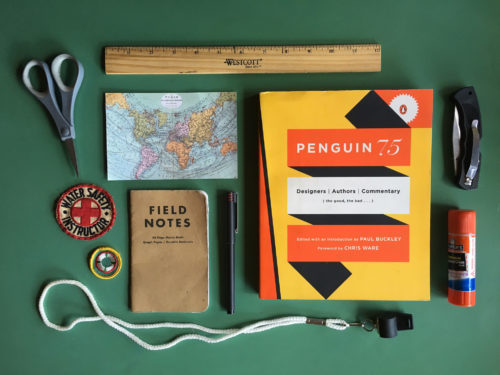By the time a reader walks by a table of newly released hardcovers or an endcap of crisp staff-pick paperbacks, each book has undergone a grooming process to become the package it presents. A good book cover grabs attention and gives its potential reader a sense of the story inside. But just as a book’s insides begin as rough drafts before being edited and published, a book’s outside goes through a robust production process in order to put its best face forward. As stunning as the results may be, the book design process is not always as smooth as a
perfectly filtered Instagram. Seven Stitches, a current Ooligan project and the forthcoming third companion title in the Blue Thread books by Ruth Tenzer Feldman, is one case where the cover-polishing process proved to be fairly challenging. Due to the dynamic nature of Seven Stitches—a time-travel, future-Portland, past-Turkey, coming-of-age, post-earthquake recovery story—capturing a fitting cover became a collage in need of careful piecing together. A variety of factors can contribute to a cover’s roadblocks on the way to a final product. Just as Feldman’s novel tackles recovery in the midst of disaster and its aftermath, let’s unpack an emergency survival kit for cover design challenges. When a design gets stuck, here are some tools that can help:
Think Outside the Cover
Considering the #goals of a book help to guide its design. For each Ooligan title, a design brief is created to ensure that its cover will carry the narrative, fit the market, and create a suitable aesthetic. Going back to the brief in the midst of design drama can serve as a reminder of priorities.
Another option is to simply go on to the next step. If something’s causing trouble, if possible, moving on to other parts of the design can open up possibilities, or at least lend some space to think about the bigger picture. In designing the cover for Seven Stitches, working on the back cover helped with envisioning the end goal, even though specific elements still needed finessing. Little by little, you’ll arrive.
Compromise Can Be Your Friend
My perfectionist side had a hard time writing that, to be honest. Sometimes design is about going out of your way to achieve that impeccably rendered art-deco look that came to you in a vision, but other times it’s about knowing when to work within a given framework and put key market considerations above personal style. A designer’s aesthetic preferences can certainly help shape the look and feel of a cover, but making sure the cover fits the story and target audience is essential. With Seven Stitches, one of the decided key factors was to
feature the novel’s protagonist on the cover, highlighting a character of color in the publishing world that so often obscures diversity. This part of the cover was particularly challenging, as we wanted to accurately represent the character, but came across some setbacks due to limited resources. Eventually, we were able to find an image that closely resembled our main character, Meryem. Including a person on the cover and using a title treatment to match the previous two Blue Thread novels helped to unify the set. These market-based design elements shaped the direction of the final cover.

Additionally, competing images can call for compromise. Even though I may really want hand-embroidered birds to be included in a cover design, if it doesn’t flow with the overall established aesthetic, it may be time to ditch it and move on. You know when you think your hairstyle is on fleek, but humidity and your best friend suggest otherwise? The same can be true with design. Embracing the natural framework of a design will make your life easier, rather than trying to force something that isn’t there. Compromise can be a good enough friend to tell you when that style just isn’t working.
“Tag me in, Coach!”
Bring in more team players. Sometimes it takes a collaborative effort and a range of perspectives and expertise to reach a common goal. While the manager role means heading up responsibility, it doesn’t mean having to do it all solo. As a designer, too, I may need to call for backup when I’ve been staring at the same project for too long and need a fresh angle and some solid suggestions to get the piece back on track. With the Seven Stitches cover, I called for reinforcement and wondered why I hadn’t done so sooner. When so many projects are underway at once, each with its own focus and direction, my tendency is to deal with challenges on my own. But bringing in others who can offer vitality to a project is often a game-changer.
No matter the design emergency, there’s usually a way to work through it. Each book cover brings its own set of challenges and opportunities for creative problem solving. Looking at the finished cover for Seven Stitches, the visual collage design is a fitting reminder of working with many moving parts—and a stellar team of collaborators—to bring everything together. When the design process gets especially difficult, expanding the vision and considering compromise can be beneficial. Better yet, ask for help. Call in your teammates. Chances are, they’ve got you covered.

